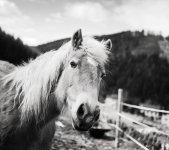Takkun
Ian M.
Weather changing, still waiting on a replacement tripod: time for fast film. I've never got on well with Ilford's faster emulsions (HP5/D400) but with the comparably high cost of TMY and sake of variety, giving them another shot.
Paterson/Adox FX-39 comes up a lot so giving it a try as well.
What's throwing me is how all over the board times are on Massive Dev, between the original Paterson 1+9 times and the alternative 1+14 times published by one Michael Scarpitti. Some of his are shorter at higher dilutions.
Compounding this: both sets suggesting a 20% increase for roll/sheet film. Not sure what purpose that is intended to serve.
Also compounding this: past forum posts here/APUG/what have you are ancient or dead ends on info.
I understand Scarpitti's times were meant to be very low-contrast for condenser enlargers and higher paper grade. I'm DSLR scanning using a video hot light as a source, so I suppose the digital equivalent of a diffusion enlarger.
Trying to understand the relationship between dilution and time. Some seem to find the box times far too long.
Derek Watkins's early review mentions higher film speed at longer times. Seems like this film behaves very differently than most I've used.
I know everyone's got a different opinion on what's 'right' (especially as I've gotten to learn Rodinal!) but just looking for a good jumping off point for experimenting.
Paterson/Adox FX-39 comes up a lot so giving it a try as well.
What's throwing me is how all over the board times are on Massive Dev, between the original Paterson 1+9 times and the alternative 1+14 times published by one Michael Scarpitti. Some of his are shorter at higher dilutions.
Compounding this: both sets suggesting a 20% increase for roll/sheet film. Not sure what purpose that is intended to serve.
Also compounding this: past forum posts here/APUG/what have you are ancient or dead ends on info.
I understand Scarpitti's times were meant to be very low-contrast for condenser enlargers and higher paper grade. I'm DSLR scanning using a video hot light as a source, so I suppose the digital equivalent of a diffusion enlarger.
Trying to understand the relationship between dilution and time. Some seem to find the box times far too long.
Derek Watkins's early review mentions higher film speed at longer times. Seems like this film behaves very differently than most I've used.
I know everyone's got a different opinion on what's 'right' (especially as I've gotten to learn Rodinal!) but just looking for a good jumping off point for experimenting.































